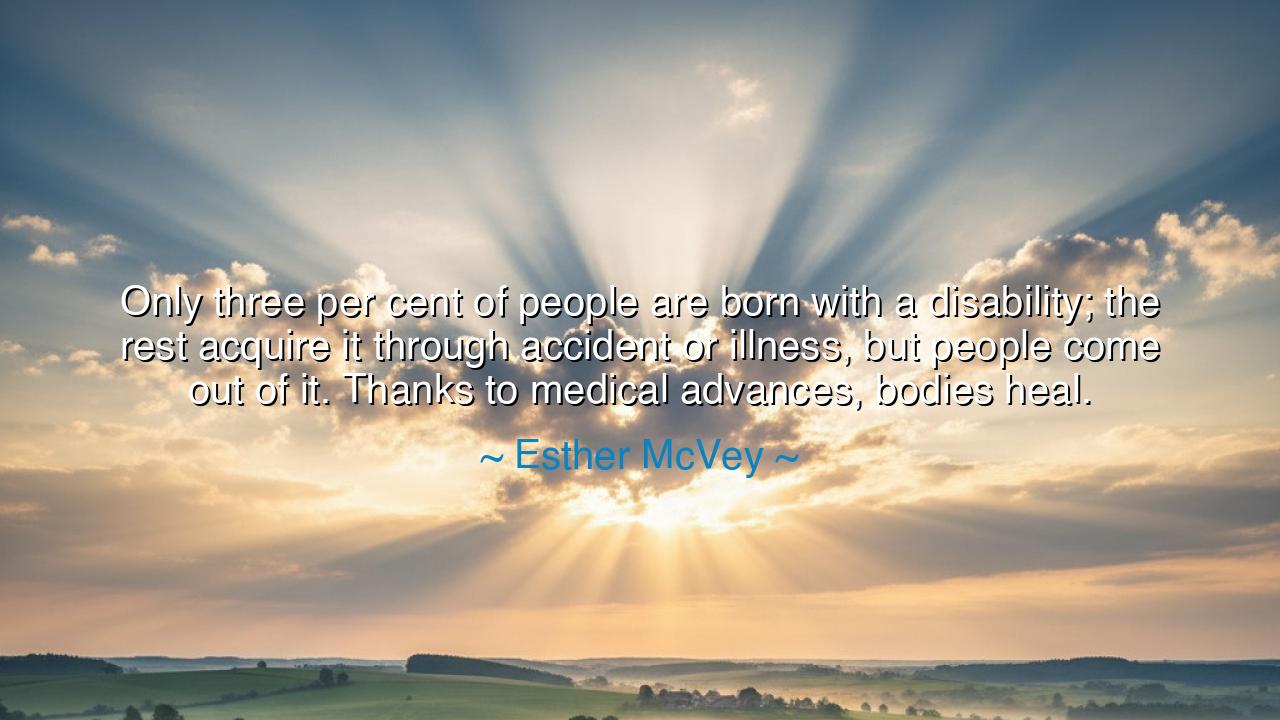
Only three per cent of people are born with a disability; the
Only three per cent of people are born with a disability; the rest acquire it through accident or illness, but people come out of it. Thanks to medical advances, bodies heal.






The words of Esther McVey shine with both realism and reverence for the human spirit: “Only three per cent of people are born with a disability; the rest acquire it through accident or illness, but people come out of it. Thanks to medical advances, bodies heal.” In these few lines lies a profound meditation on resilience, renewal, and the divine mystery of the human form. Her words remind us that fragility and strength dwell side by side within us—that suffering, though it may strike suddenly, need not define the rest of our journey. Through compassion, science, and the will to endure, even the wounded may rise again to walk in light.
From the beginning of time, humanity has wrestled with the limits of the flesh. The ancients told stories of heroes who fell, not to death, but to injury—yet who found within their pain the seed of transformation. So it is in McVey’s reflection, which honors both the fragility of life and the brilliance of healing. To say that “bodies heal” is not a simple observation of medicine, but an act of faith in human progress and perseverance. For though wounds may break the body, they also reveal the strength of the soul. The same hands that tremble in suffering may, through care and treatment, be made whole again.
Disability, in her words, is not a mark of defeat, but part of the shared human condition. Few are born with it, she reminds us, yet nearly all will taste its shadow—whether through accident, illness, or the slow passage of age. Thus, the boundary between the able and the disabled is not fixed but fluid, teaching us humility. The strong of today may become the weak of tomorrow, and the weak may yet rise again. In this way, McVey’s message carries the ancient moral that all should show kindness, for fortune turns like the seasons, and no man stands beyond the reach of vulnerability.
Consider the tale of Bethany Hamilton, the surfer who, after losing her arm to a shark attack at thirteen, returned to the waves less than a month later. Her story is living proof of what McVey calls “coming out of it.” Though her body was changed, her spirit remained unbroken. Through faith, determination, and the care of those around her, she did not simply heal—she transcended her pain, proving that the human will is mightier than any wound. So too does medical science, with its endless ingenuity, reflect this same defiance of despair. Every medical advance, every act of healing, is an echo of humanity’s eternal vow to overcome suffering.
And yet, McVey’s words also carry a quieter wisdom: that healing is not always the same as restoration. Some bodies mend; others adapt. Some wounds close; others become part of one’s story. The beauty of humanity lies not in perfection, but in persistence. Even those who do not return to the lives they once had still rise in strength, crafting new paths, new dreams, and new forms of freedom. In this way, disability becomes not a limitation, but a transformation—a rebirth of purpose within the bounds of flesh.
Her statement is also a hymn to modern medicine, that sacred alliance between human intellect and compassion. The healer’s art has evolved from the herbs of the ancient apothecary to the miracles of surgery and biogenetics. Yet the essence remains unchanged: to restore balance, to relieve pain, to preserve hope. The body’s capacity to heal is one of nature’s greatest gifts, but it is the heart’s capacity to believe in that healing that completes the miracle. When body and will work together, aided by knowledge and care, even the deepest wounds may fade into strength.
And so, O listener of these truths, take this teaching to heart: though life may strike you with pain or loss, do not surrender to despair. Healing is both a process of the body and a choice of the spirit. Honor those who study and labor to make that healing possible—the doctors, the researchers, the caregivers—for they are the torchbearers of humanity’s compassion. But also remember that each of us carries within the power to endure, to adapt, to overcome.
In the end, Esther McVey’s words remind us that life is not defined by the moment of injury, but by the journey of recovery. The body may falter, but it was born to mend. The spirit may fall, but it was made to rise. Let us then walk forward with gratitude for the medical advances that serve as our armor, and with reverence for the courage that lies within every heart that chooses to heal. For in healing, we do not merely survive—we honor the very essence of what it means to be human.






AAdministratorAdministrator
Welcome, honored guests. Please leave a comment, we will respond soon